Analyzing Emotion and its Influence in the Modern Workplace
VerifiedAdded on 2023/03/29
|10
|2520
|256
Essay
AI Summary
This essay delves into the significant influence of emotions within the workplace, examining how they shape employee behavior, job satisfaction, and overall organizational performance. The introduction defines cognition and its role in understanding and interpreting information, with a focus on cognitive processes like perception, attention, memory, language, and thinking. The essay explores various types of emotions, categorized by psychologists like Paul Ekman, and discusses how these emotions interact with cognitive and biological factors. It introduces the Affective Events Theory (AET) by Weiss and Cropanzano, which explains the impact of moods and emotions on job satisfaction and performance. The discussion section elaborates on the interplay between pleasant and unpleasant moods, brain activity, and cognitive processes, highlighting the role of appraisal theories and the Two-Factor Theory in motivating employees. The essay emphasizes that positive factors like rewards and recognition enhance employee satisfaction and productivity, while negative factors can lead to demotivation and decreased performance. The overall conclusion underscores the importance of understanding and managing emotions to foster a positive and productive work environment.
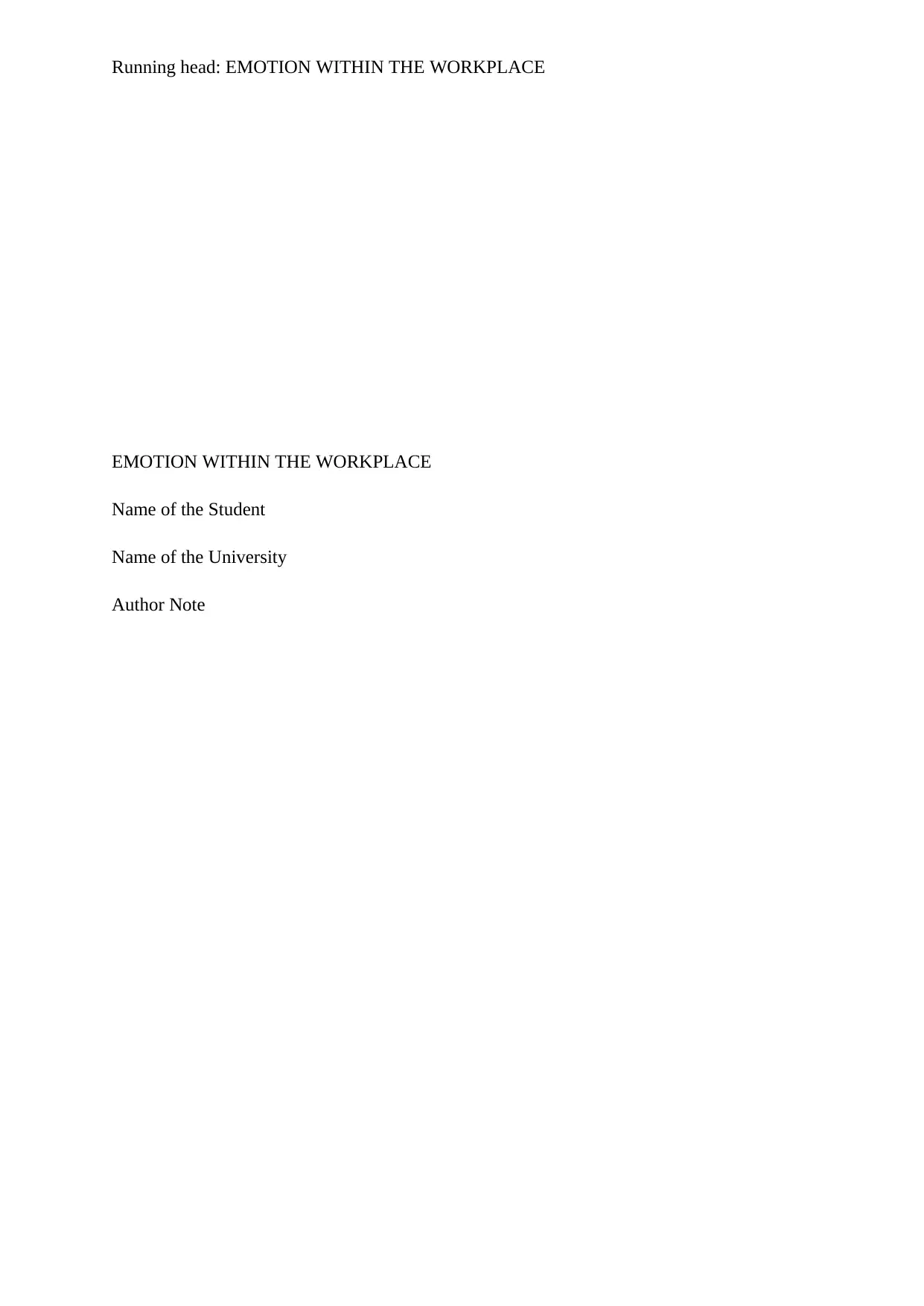
Running head: EMOTION WITHIN THE WORKPLACE
EMOTION WITHIN THE WORKPLACE
Name of the Student
Name of the University
Author Note
EMOTION WITHIN THE WORKPLACE
Name of the Student
Name of the University
Author Note
Paraphrase This Document
Need a fresh take? Get an instant paraphrase of this document with our AI Paraphraser
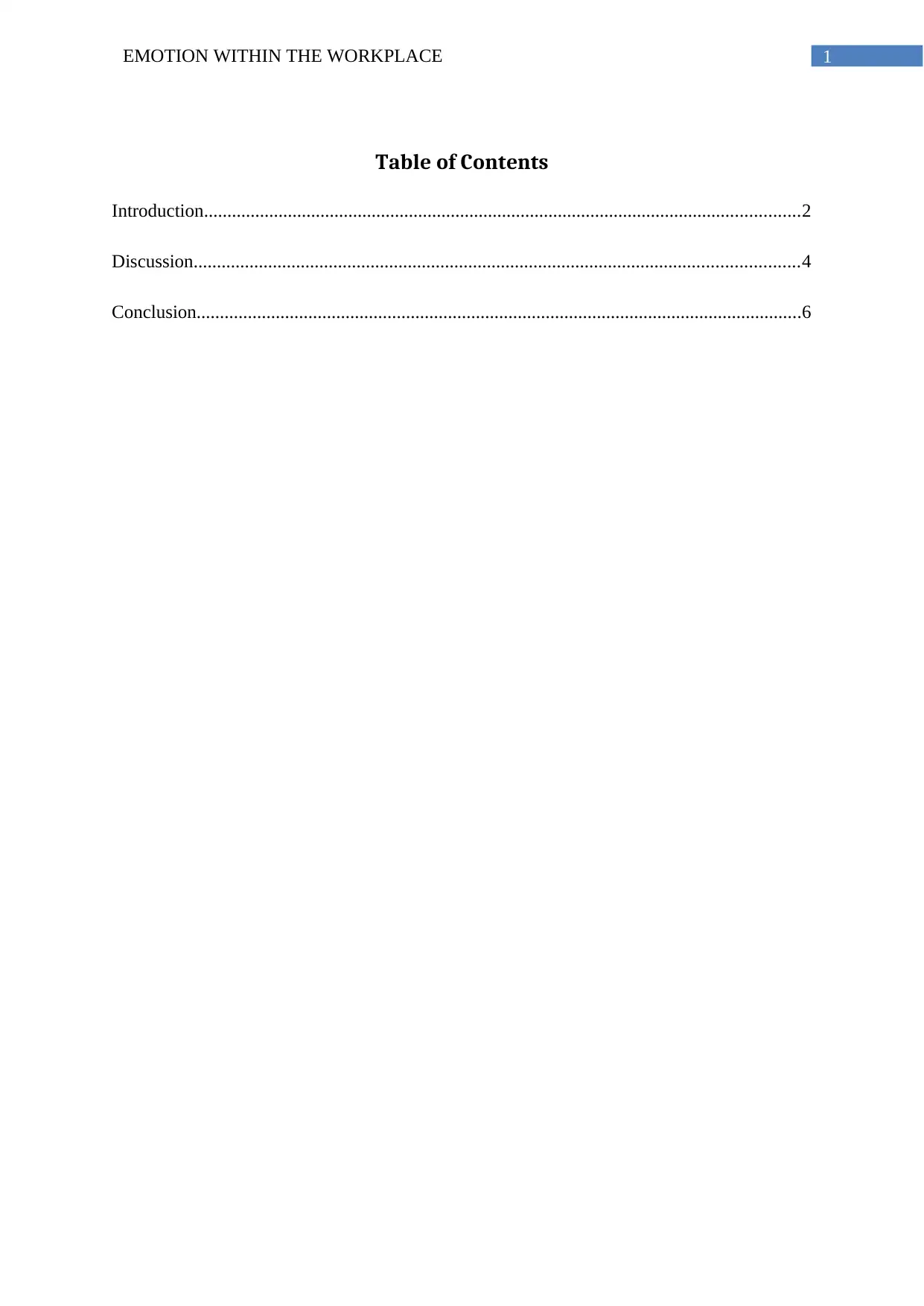
1EMOTION WITHIN THE WORKPLACE
Table of Contents
Introduction................................................................................................................................2
Discussion..................................................................................................................................4
Conclusion..................................................................................................................................6
Table of Contents
Introduction................................................................................................................................2
Discussion..................................................................................................................................4
Conclusion..................................................................................................................................6
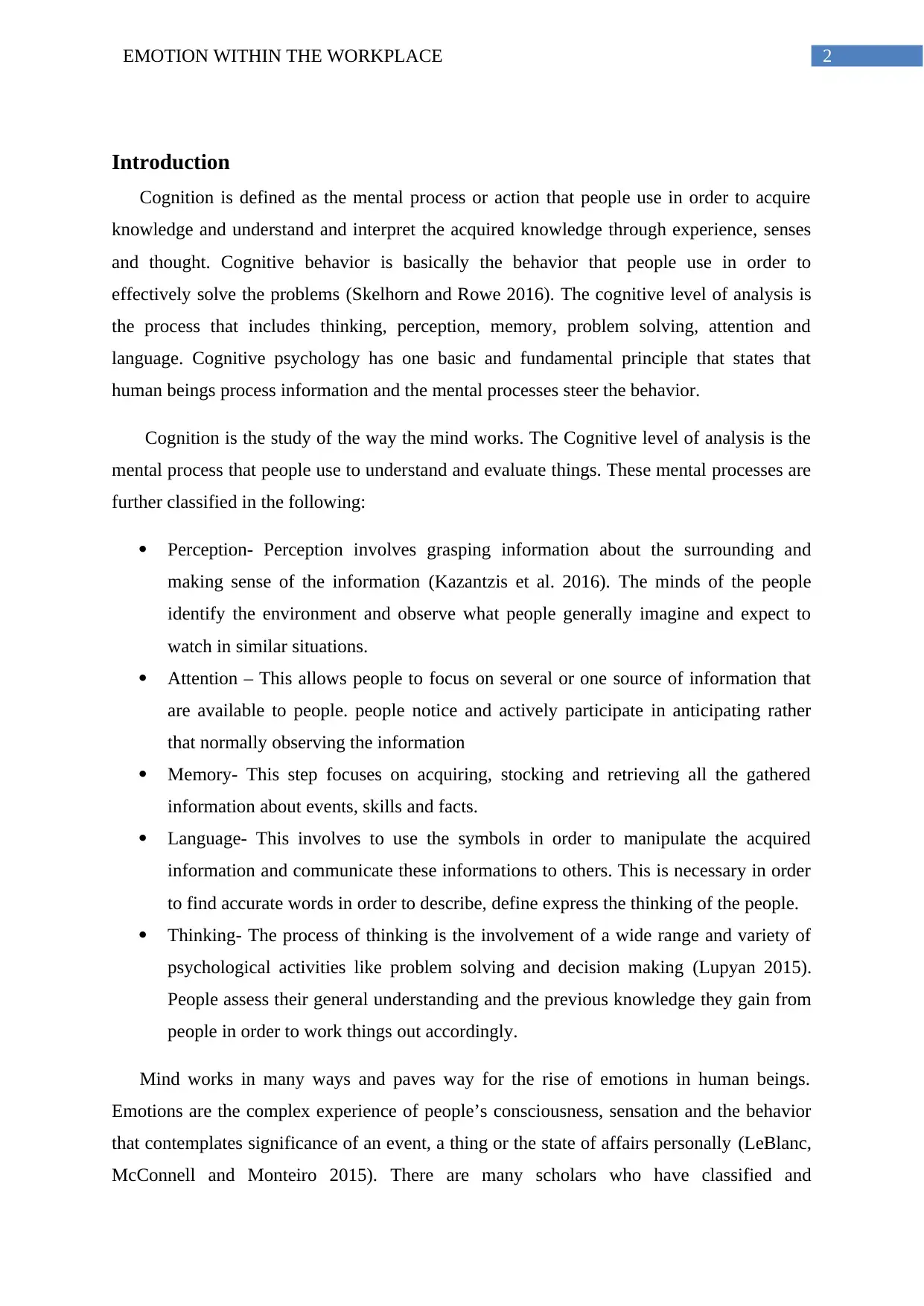
2EMOTION WITHIN THE WORKPLACE
Introduction
Cognition is defined as the mental process or action that people use in order to acquire
knowledge and understand and interpret the acquired knowledge through experience, senses
and thought. Cognitive behavior is basically the behavior that people use in order to
effectively solve the problems (Skelhorn and Rowe 2016). The cognitive level of analysis is
the process that includes thinking, perception, memory, problem solving, attention and
language. Cognitive psychology has one basic and fundamental principle that states that
human beings process information and the mental processes steer the behavior.
Cognition is the study of the way the mind works. The Cognitive level of analysis is the
mental process that people use to understand and evaluate things. These mental processes are
further classified in the following:
Perception- Perception involves grasping information about the surrounding and
making sense of the information (Kazantzis et al. 2016). The minds of the people
identify the environment and observe what people generally imagine and expect to
watch in similar situations.
Attention – This allows people to focus on several or one source of information that
are available to people. people notice and actively participate in anticipating rather
that normally observing the information
Memory- This step focuses on acquiring, stocking and retrieving all the gathered
information about events, skills and facts.
Language- This involves to use the symbols in order to manipulate the acquired
information and communicate these informations to others. This is necessary in order
to find accurate words in order to describe, define express the thinking of the people.
Thinking- The process of thinking is the involvement of a wide range and variety of
psychological activities like problem solving and decision making (Lupyan 2015).
People assess their general understanding and the previous knowledge they gain from
people in order to work things out accordingly.
Mind works in many ways and paves way for the rise of emotions in human beings.
Emotions are the complex experience of people’s consciousness, sensation and the behavior
that contemplates significance of an event, a thing or the state of affairs personally (LeBlanc,
McConnell and Monteiro 2015). There are many scholars who have classified and
Introduction
Cognition is defined as the mental process or action that people use in order to acquire
knowledge and understand and interpret the acquired knowledge through experience, senses
and thought. Cognitive behavior is basically the behavior that people use in order to
effectively solve the problems (Skelhorn and Rowe 2016). The cognitive level of analysis is
the process that includes thinking, perception, memory, problem solving, attention and
language. Cognitive psychology has one basic and fundamental principle that states that
human beings process information and the mental processes steer the behavior.
Cognition is the study of the way the mind works. The Cognitive level of analysis is the
mental process that people use to understand and evaluate things. These mental processes are
further classified in the following:
Perception- Perception involves grasping information about the surrounding and
making sense of the information (Kazantzis et al. 2016). The minds of the people
identify the environment and observe what people generally imagine and expect to
watch in similar situations.
Attention – This allows people to focus on several or one source of information that
are available to people. people notice and actively participate in anticipating rather
that normally observing the information
Memory- This step focuses on acquiring, stocking and retrieving all the gathered
information about events, skills and facts.
Language- This involves to use the symbols in order to manipulate the acquired
information and communicate these informations to others. This is necessary in order
to find accurate words in order to describe, define express the thinking of the people.
Thinking- The process of thinking is the involvement of a wide range and variety of
psychological activities like problem solving and decision making (Lupyan 2015).
People assess their general understanding and the previous knowledge they gain from
people in order to work things out accordingly.
Mind works in many ways and paves way for the rise of emotions in human beings.
Emotions are the complex experience of people’s consciousness, sensation and the behavior
that contemplates significance of an event, a thing or the state of affairs personally (LeBlanc,
McConnell and Monteiro 2015). There are many scholars who have classified and
⊘ This is a preview!⊘
Do you want full access?
Subscribe today to unlock all pages.

Trusted by 1+ million students worldwide
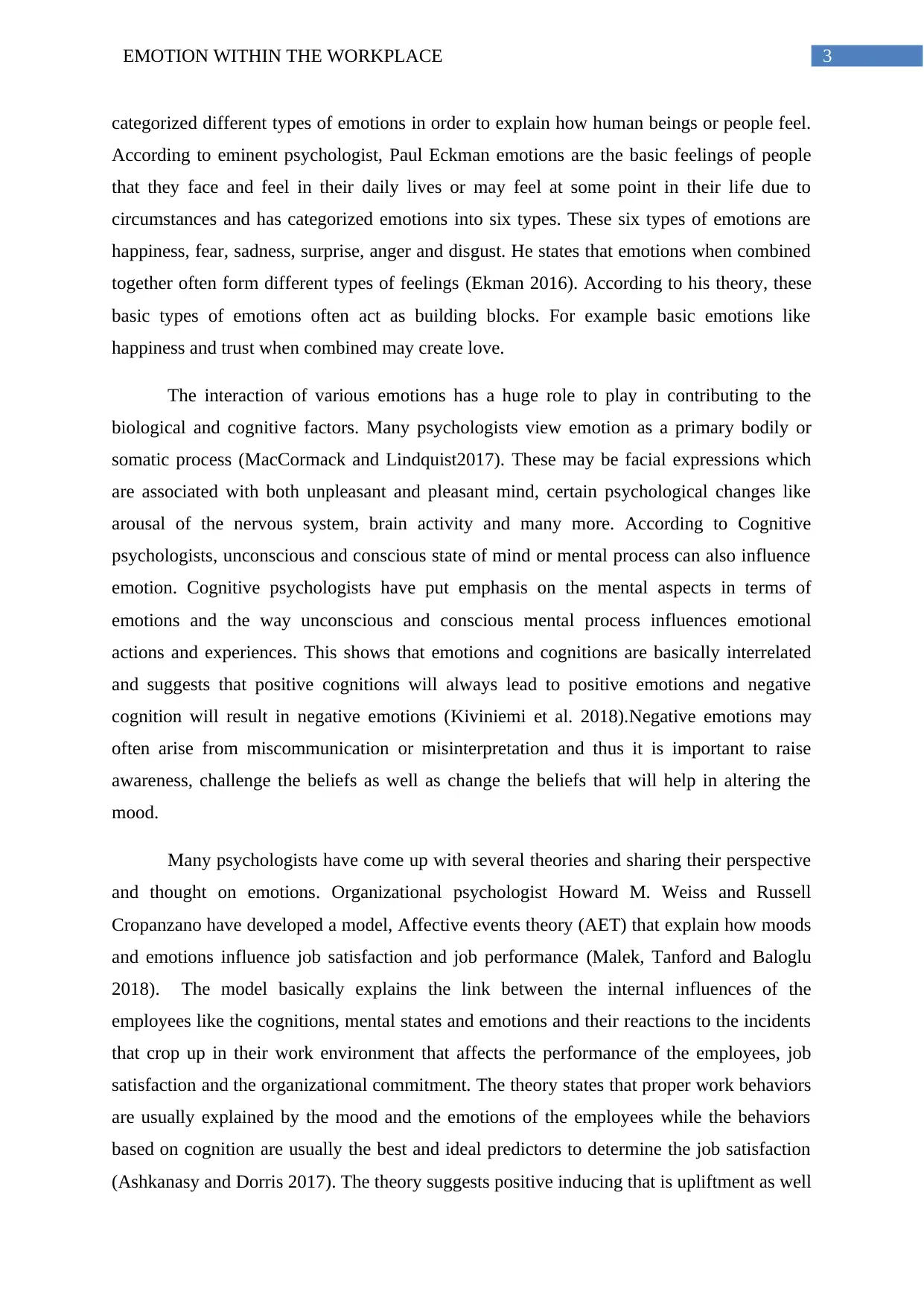
3EMOTION WITHIN THE WORKPLACE
categorized different types of emotions in order to explain how human beings or people feel.
According to eminent psychologist, Paul Eckman emotions are the basic feelings of people
that they face and feel in their daily lives or may feel at some point in their life due to
circumstances and has categorized emotions into six types. These six types of emotions are
happiness, fear, sadness, surprise, anger and disgust. He states that emotions when combined
together often form different types of feelings (Ekman 2016). According to his theory, these
basic types of emotions often act as building blocks. For example basic emotions like
happiness and trust when combined may create love.
The interaction of various emotions has a huge role to play in contributing to the
biological and cognitive factors. Many psychologists view emotion as a primary bodily or
somatic process (MacCormack and Lindquist2017). These may be facial expressions which
are associated with both unpleasant and pleasant mind, certain psychological changes like
arousal of the nervous system, brain activity and many more. According to Cognitive
psychologists, unconscious and conscious state of mind or mental process can also influence
emotion. Cognitive psychologists have put emphasis on the mental aspects in terms of
emotions and the way unconscious and conscious mental process influences emotional
actions and experiences. This shows that emotions and cognitions are basically interrelated
and suggests that positive cognitions will always lead to positive emotions and negative
cognition will result in negative emotions (Kiviniemi et al. 2018).Negative emotions may
often arise from miscommunication or misinterpretation and thus it is important to raise
awareness, challenge the beliefs as well as change the beliefs that will help in altering the
mood.
Many psychologists have come up with several theories and sharing their perspective
and thought on emotions. Organizational psychologist Howard M. Weiss and Russell
Cropanzano have developed a model, Affective events theory (AET) that explain how moods
and emotions influence job satisfaction and job performance (Malek, Tanford and Baloglu
2018). The model basically explains the link between the internal influences of the
employees like the cognitions, mental states and emotions and their reactions to the incidents
that crop up in their work environment that affects the performance of the employees, job
satisfaction and the organizational commitment. The theory states that proper work behaviors
are usually explained by the mood and the emotions of the employees while the behaviors
based on cognition are usually the best and ideal predictors to determine the job satisfaction
(Ashkanasy and Dorris 2017). The theory suggests positive inducing that is upliftment as well
categorized different types of emotions in order to explain how human beings or people feel.
According to eminent psychologist, Paul Eckman emotions are the basic feelings of people
that they face and feel in their daily lives or may feel at some point in their life due to
circumstances and has categorized emotions into six types. These six types of emotions are
happiness, fear, sadness, surprise, anger and disgust. He states that emotions when combined
together often form different types of feelings (Ekman 2016). According to his theory, these
basic types of emotions often act as building blocks. For example basic emotions like
happiness and trust when combined may create love.
The interaction of various emotions has a huge role to play in contributing to the
biological and cognitive factors. Many psychologists view emotion as a primary bodily or
somatic process (MacCormack and Lindquist2017). These may be facial expressions which
are associated with both unpleasant and pleasant mind, certain psychological changes like
arousal of the nervous system, brain activity and many more. According to Cognitive
psychologists, unconscious and conscious state of mind or mental process can also influence
emotion. Cognitive psychologists have put emphasis on the mental aspects in terms of
emotions and the way unconscious and conscious mental process influences emotional
actions and experiences. This shows that emotions and cognitions are basically interrelated
and suggests that positive cognitions will always lead to positive emotions and negative
cognition will result in negative emotions (Kiviniemi et al. 2018).Negative emotions may
often arise from miscommunication or misinterpretation and thus it is important to raise
awareness, challenge the beliefs as well as change the beliefs that will help in altering the
mood.
Many psychologists have come up with several theories and sharing their perspective
and thought on emotions. Organizational psychologist Howard M. Weiss and Russell
Cropanzano have developed a model, Affective events theory (AET) that explain how moods
and emotions influence job satisfaction and job performance (Malek, Tanford and Baloglu
2018). The model basically explains the link between the internal influences of the
employees like the cognitions, mental states and emotions and their reactions to the incidents
that crop up in their work environment that affects the performance of the employees, job
satisfaction and the organizational commitment. The theory states that proper work behaviors
are usually explained by the mood and the emotions of the employees while the behaviors
based on cognition are usually the best and ideal predictors to determine the job satisfaction
(Ashkanasy and Dorris 2017). The theory suggests positive inducing that is upliftment as well
Paraphrase This Document
Need a fresh take? Get an instant paraphrase of this document with our AI Paraphraser
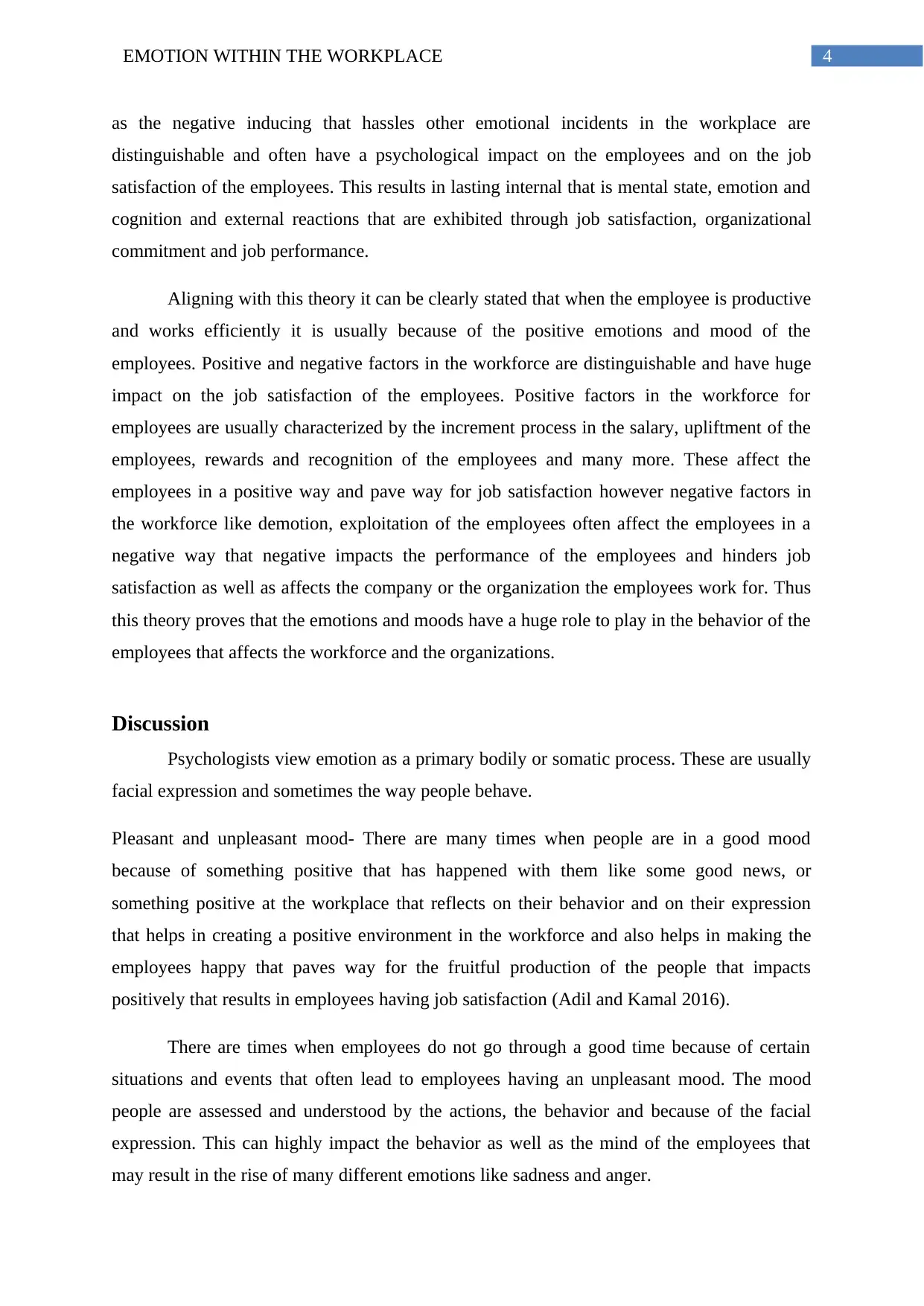
4EMOTION WITHIN THE WORKPLACE
as the negative inducing that hassles other emotional incidents in the workplace are
distinguishable and often have a psychological impact on the employees and on the job
satisfaction of the employees. This results in lasting internal that is mental state, emotion and
cognition and external reactions that are exhibited through job satisfaction, organizational
commitment and job performance.
Aligning with this theory it can be clearly stated that when the employee is productive
and works efficiently it is usually because of the positive emotions and mood of the
employees. Positive and negative factors in the workforce are distinguishable and have huge
impact on the job satisfaction of the employees. Positive factors in the workforce for
employees are usually characterized by the increment process in the salary, upliftment of the
employees, rewards and recognition of the employees and many more. These affect the
employees in a positive way and pave way for job satisfaction however negative factors in
the workforce like demotion, exploitation of the employees often affect the employees in a
negative way that negative impacts the performance of the employees and hinders job
satisfaction as well as affects the company or the organization the employees work for. Thus
this theory proves that the emotions and moods have a huge role to play in the behavior of the
employees that affects the workforce and the organizations.
Discussion
Psychologists view emotion as a primary bodily or somatic process. These are usually
facial expression and sometimes the way people behave.
Pleasant and unpleasant mood- There are many times when people are in a good mood
because of something positive that has happened with them like some good news, or
something positive at the workplace that reflects on their behavior and on their expression
that helps in creating a positive environment in the workforce and also helps in making the
employees happy that paves way for the fruitful production of the people that impacts
positively that results in employees having job satisfaction (Adil and Kamal 2016).
There are times when employees do not go through a good time because of certain
situations and events that often lead to employees having an unpleasant mood. The mood
people are assessed and understood by the actions, the behavior and because of the facial
expression. This can highly impact the behavior as well as the mind of the employees that
may result in the rise of many different emotions like sadness and anger.
as the negative inducing that hassles other emotional incidents in the workplace are
distinguishable and often have a psychological impact on the employees and on the job
satisfaction of the employees. This results in lasting internal that is mental state, emotion and
cognition and external reactions that are exhibited through job satisfaction, organizational
commitment and job performance.
Aligning with this theory it can be clearly stated that when the employee is productive
and works efficiently it is usually because of the positive emotions and mood of the
employees. Positive and negative factors in the workforce are distinguishable and have huge
impact on the job satisfaction of the employees. Positive factors in the workforce for
employees are usually characterized by the increment process in the salary, upliftment of the
employees, rewards and recognition of the employees and many more. These affect the
employees in a positive way and pave way for job satisfaction however negative factors in
the workforce like demotion, exploitation of the employees often affect the employees in a
negative way that negative impacts the performance of the employees and hinders job
satisfaction as well as affects the company or the organization the employees work for. Thus
this theory proves that the emotions and moods have a huge role to play in the behavior of the
employees that affects the workforce and the organizations.
Discussion
Psychologists view emotion as a primary bodily or somatic process. These are usually
facial expression and sometimes the way people behave.
Pleasant and unpleasant mood- There are many times when people are in a good mood
because of something positive that has happened with them like some good news, or
something positive at the workplace that reflects on their behavior and on their expression
that helps in creating a positive environment in the workforce and also helps in making the
employees happy that paves way for the fruitful production of the people that impacts
positively that results in employees having job satisfaction (Adil and Kamal 2016).
There are times when employees do not go through a good time because of certain
situations and events that often lead to employees having an unpleasant mood. The mood
people are assessed and understood by the actions, the behavior and because of the facial
expression. This can highly impact the behavior as well as the mind of the employees that
may result in the rise of many different emotions like sadness and anger.
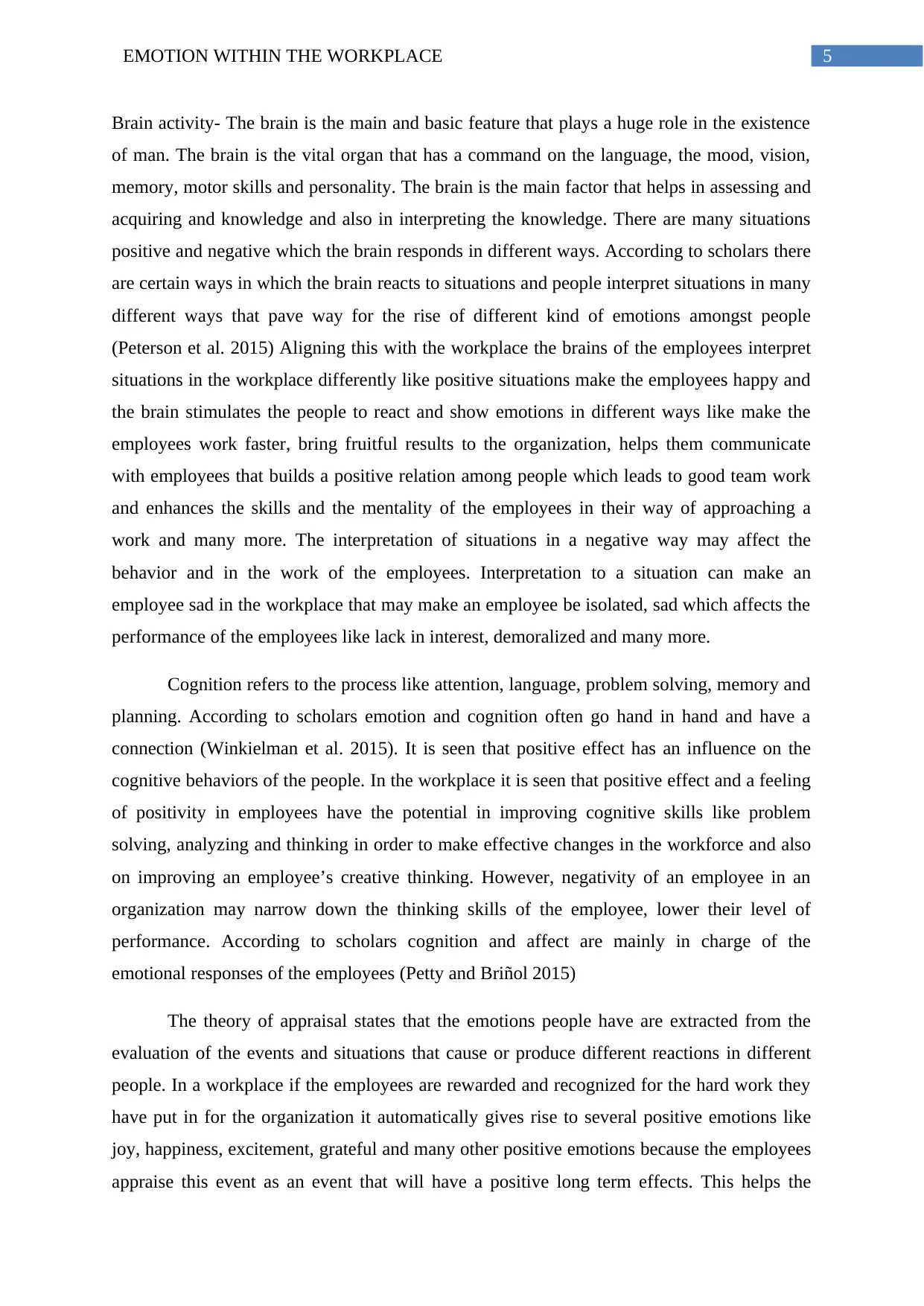
5EMOTION WITHIN THE WORKPLACE
Brain activity- The brain is the main and basic feature that plays a huge role in the existence
of man. The brain is the vital organ that has a command on the language, the mood, vision,
memory, motor skills and personality. The brain is the main factor that helps in assessing and
acquiring and knowledge and also in interpreting the knowledge. There are many situations
positive and negative which the brain responds in different ways. According to scholars there
are certain ways in which the brain reacts to situations and people interpret situations in many
different ways that pave way for the rise of different kind of emotions amongst people
(Peterson et al. 2015) Aligning this with the workplace the brains of the employees interpret
situations in the workplace differently like positive situations make the employees happy and
the brain stimulates the people to react and show emotions in different ways like make the
employees work faster, bring fruitful results to the organization, helps them communicate
with employees that builds a positive relation among people which leads to good team work
and enhances the skills and the mentality of the employees in their way of approaching a
work and many more. The interpretation of situations in a negative way may affect the
behavior and in the work of the employees. Interpretation to a situation can make an
employee sad in the workplace that may make an employee be isolated, sad which affects the
performance of the employees like lack in interest, demoralized and many more.
Cognition refers to the process like attention, language, problem solving, memory and
planning. According to scholars emotion and cognition often go hand in hand and have a
connection (Winkielman et al. 2015). It is seen that positive effect has an influence on the
cognitive behaviors of the people. In the workplace it is seen that positive effect and a feeling
of positivity in employees have the potential in improving cognitive skills like problem
solving, analyzing and thinking in order to make effective changes in the workforce and also
on improving an employee’s creative thinking. However, negativity of an employee in an
organization may narrow down the thinking skills of the employee, lower their level of
performance. According to scholars cognition and affect are mainly in charge of the
emotional responses of the employees (Petty and Briñol 2015)
The theory of appraisal states that the emotions people have are extracted from the
evaluation of the events and situations that cause or produce different reactions in different
people. In a workplace if the employees are rewarded and recognized for the hard work they
have put in for the organization it automatically gives rise to several positive emotions like
joy, happiness, excitement, grateful and many other positive emotions because the employees
appraise this event as an event that will have a positive long term effects. This helps the
Brain activity- The brain is the main and basic feature that plays a huge role in the existence
of man. The brain is the vital organ that has a command on the language, the mood, vision,
memory, motor skills and personality. The brain is the main factor that helps in assessing and
acquiring and knowledge and also in interpreting the knowledge. There are many situations
positive and negative which the brain responds in different ways. According to scholars there
are certain ways in which the brain reacts to situations and people interpret situations in many
different ways that pave way for the rise of different kind of emotions amongst people
(Peterson et al. 2015) Aligning this with the workplace the brains of the employees interpret
situations in the workplace differently like positive situations make the employees happy and
the brain stimulates the people to react and show emotions in different ways like make the
employees work faster, bring fruitful results to the organization, helps them communicate
with employees that builds a positive relation among people which leads to good team work
and enhances the skills and the mentality of the employees in their way of approaching a
work and many more. The interpretation of situations in a negative way may affect the
behavior and in the work of the employees. Interpretation to a situation can make an
employee sad in the workplace that may make an employee be isolated, sad which affects the
performance of the employees like lack in interest, demoralized and many more.
Cognition refers to the process like attention, language, problem solving, memory and
planning. According to scholars emotion and cognition often go hand in hand and have a
connection (Winkielman et al. 2015). It is seen that positive effect has an influence on the
cognitive behaviors of the people. In the workplace it is seen that positive effect and a feeling
of positivity in employees have the potential in improving cognitive skills like problem
solving, analyzing and thinking in order to make effective changes in the workforce and also
on improving an employee’s creative thinking. However, negativity of an employee in an
organization may narrow down the thinking skills of the employee, lower their level of
performance. According to scholars cognition and affect are mainly in charge of the
emotional responses of the employees (Petty and Briñol 2015)
The theory of appraisal states that the emotions people have are extracted from the
evaluation of the events and situations that cause or produce different reactions in different
people. In a workplace if the employees are rewarded and recognized for the hard work they
have put in for the organization it automatically gives rise to several positive emotions like
joy, happiness, excitement, grateful and many other positive emotions because the employees
appraise this event as an event that will have a positive long term effects. This helps the
⊘ This is a preview!⊘
Do you want full access?
Subscribe today to unlock all pages.

Trusted by 1+ million students worldwide
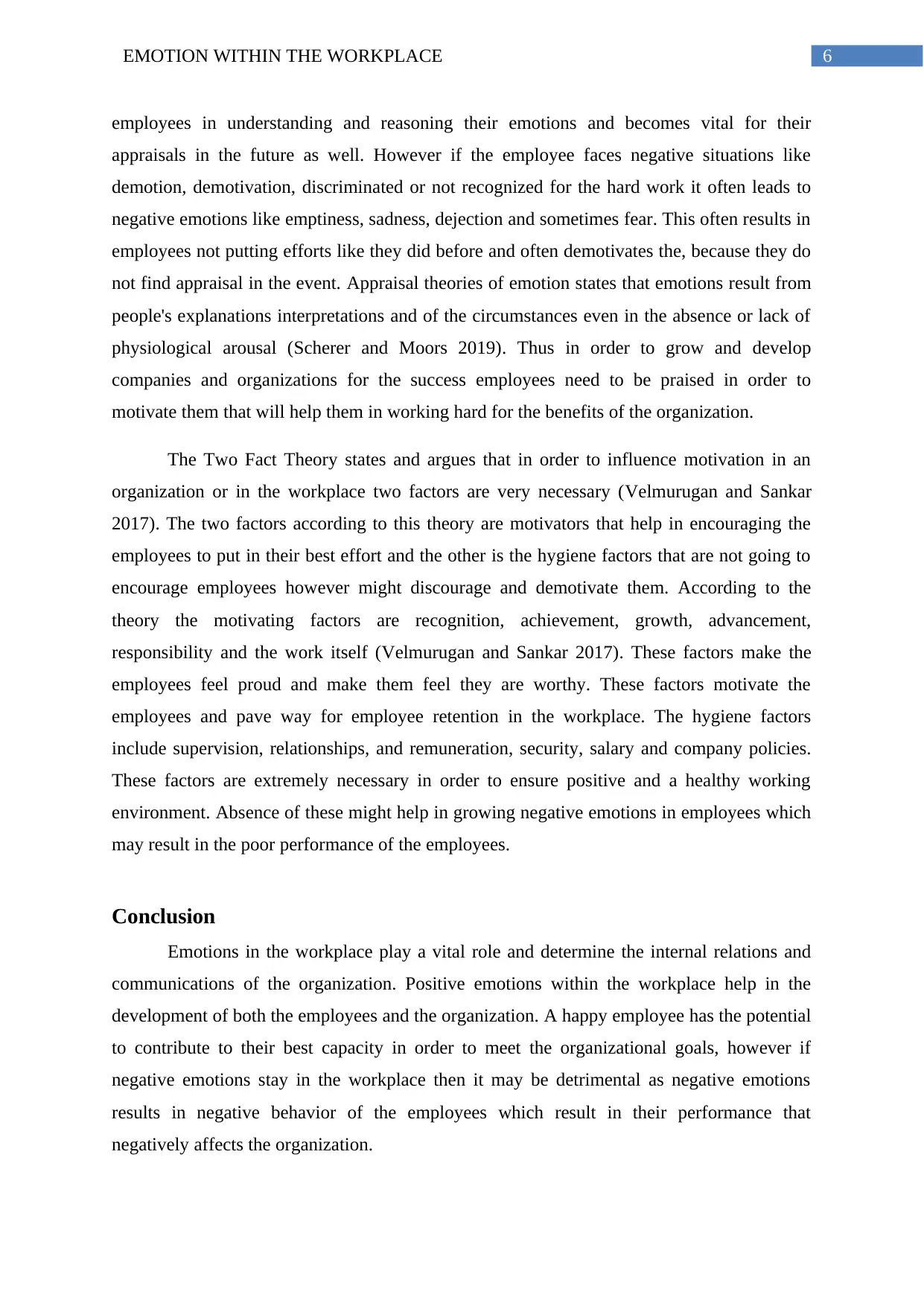
6EMOTION WITHIN THE WORKPLACE
employees in understanding and reasoning their emotions and becomes vital for their
appraisals in the future as well. However if the employee faces negative situations like
demotion, demotivation, discriminated or not recognized for the hard work it often leads to
negative emotions like emptiness, sadness, dejection and sometimes fear. This often results in
employees not putting efforts like they did before and often demotivates the, because they do
not find appraisal in the event. Appraisal theories of emotion states that emotions result from
people's explanations interpretations and of the circumstances even in the absence or lack of
physiological arousal (Scherer and Moors 2019). Thus in order to grow and develop
companies and organizations for the success employees need to be praised in order to
motivate them that will help them in working hard for the benefits of the organization.
The Two Fact Theory states and argues that in order to influence motivation in an
organization or in the workplace two factors are very necessary (Velmurugan and Sankar
2017). The two factors according to this theory are motivators that help in encouraging the
employees to put in their best effort and the other is the hygiene factors that are not going to
encourage employees however might discourage and demotivate them. According to the
theory the motivating factors are recognition, achievement, growth, advancement,
responsibility and the work itself (Velmurugan and Sankar 2017). These factors make the
employees feel proud and make them feel they are worthy. These factors motivate the
employees and pave way for employee retention in the workplace. The hygiene factors
include supervision, relationships, and remuneration, security, salary and company policies.
These factors are extremely necessary in order to ensure positive and a healthy working
environment. Absence of these might help in growing negative emotions in employees which
may result in the poor performance of the employees.
Conclusion
Emotions in the workplace play a vital role and determine the internal relations and
communications of the organization. Positive emotions within the workplace help in the
development of both the employees and the organization. A happy employee has the potential
to contribute to their best capacity in order to meet the organizational goals, however if
negative emotions stay in the workplace then it may be detrimental as negative emotions
results in negative behavior of the employees which result in their performance that
negatively affects the organization.
employees in understanding and reasoning their emotions and becomes vital for their
appraisals in the future as well. However if the employee faces negative situations like
demotion, demotivation, discriminated or not recognized for the hard work it often leads to
negative emotions like emptiness, sadness, dejection and sometimes fear. This often results in
employees not putting efforts like they did before and often demotivates the, because they do
not find appraisal in the event. Appraisal theories of emotion states that emotions result from
people's explanations interpretations and of the circumstances even in the absence or lack of
physiological arousal (Scherer and Moors 2019). Thus in order to grow and develop
companies and organizations for the success employees need to be praised in order to
motivate them that will help them in working hard for the benefits of the organization.
The Two Fact Theory states and argues that in order to influence motivation in an
organization or in the workplace two factors are very necessary (Velmurugan and Sankar
2017). The two factors according to this theory are motivators that help in encouraging the
employees to put in their best effort and the other is the hygiene factors that are not going to
encourage employees however might discourage and demotivate them. According to the
theory the motivating factors are recognition, achievement, growth, advancement,
responsibility and the work itself (Velmurugan and Sankar 2017). These factors make the
employees feel proud and make them feel they are worthy. These factors motivate the
employees and pave way for employee retention in the workplace. The hygiene factors
include supervision, relationships, and remuneration, security, salary and company policies.
These factors are extremely necessary in order to ensure positive and a healthy working
environment. Absence of these might help in growing negative emotions in employees which
may result in the poor performance of the employees.
Conclusion
Emotions in the workplace play a vital role and determine the internal relations and
communications of the organization. Positive emotions within the workplace help in the
development of both the employees and the organization. A happy employee has the potential
to contribute to their best capacity in order to meet the organizational goals, however if
negative emotions stay in the workplace then it may be detrimental as negative emotions
results in negative behavior of the employees which result in their performance that
negatively affects the organization.
Paraphrase This Document
Need a fresh take? Get an instant paraphrase of this document with our AI Paraphraser
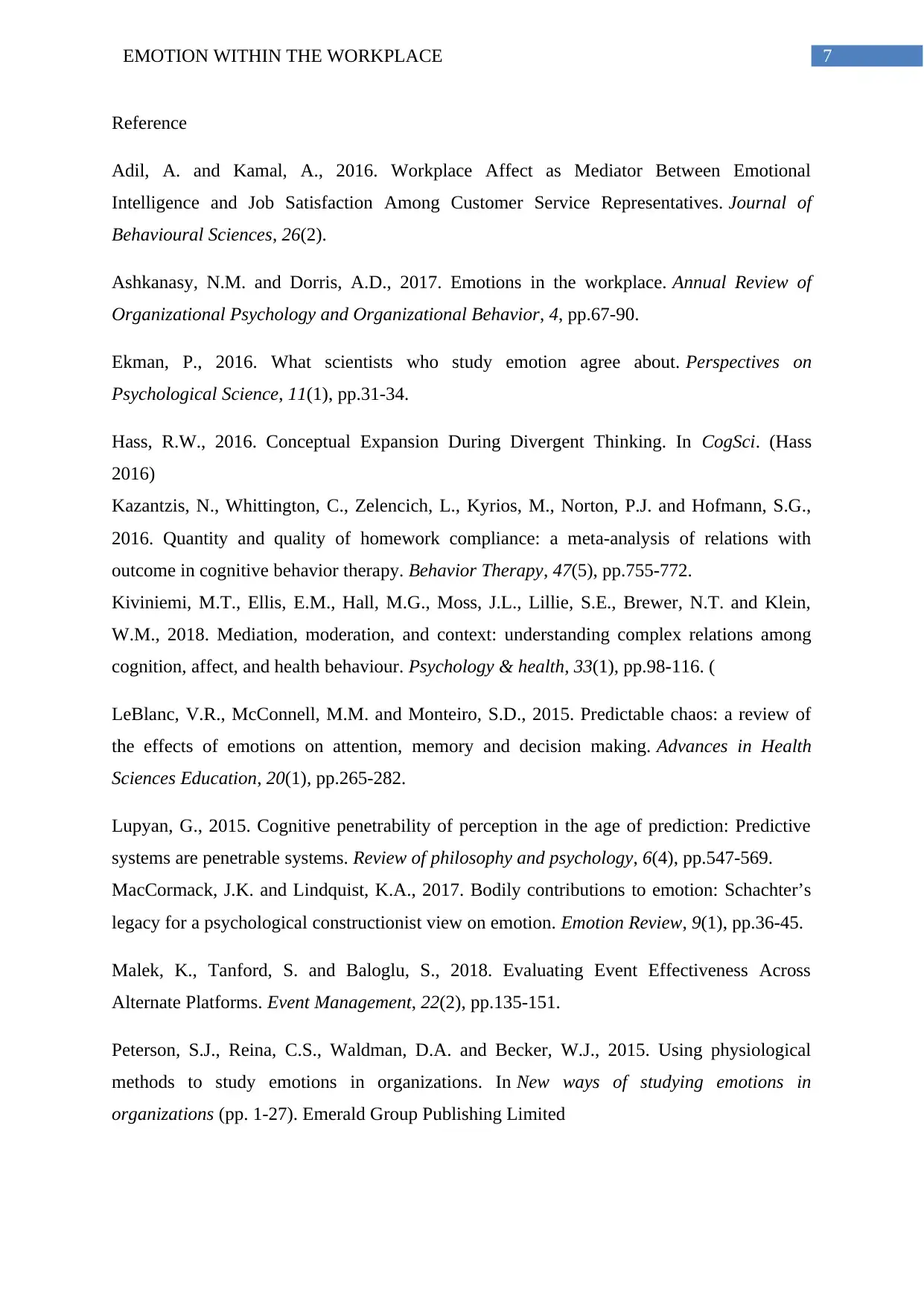
7EMOTION WITHIN THE WORKPLACE
Reference
Adil, A. and Kamal, A., 2016. Workplace Affect as Mediator Between Emotional
Intelligence and Job Satisfaction Among Customer Service Representatives. Journal of
Behavioural Sciences, 26(2).
Ashkanasy, N.M. and Dorris, A.D., 2017. Emotions in the workplace. Annual Review of
Organizational Psychology and Organizational Behavior, 4, pp.67-90.
Ekman, P., 2016. What scientists who study emotion agree about. Perspectives on
Psychological Science, 11(1), pp.31-34.
Hass, R.W., 2016. Conceptual Expansion During Divergent Thinking. In CogSci. (Hass
2016)
Kazantzis, N., Whittington, C., Zelencich, L., Kyrios, M., Norton, P.J. and Hofmann, S.G.,
2016. Quantity and quality of homework compliance: a meta-analysis of relations with
outcome in cognitive behavior therapy. Behavior Therapy, 47(5), pp.755-772.
Kiviniemi, M.T., Ellis, E.M., Hall, M.G., Moss, J.L., Lillie, S.E., Brewer, N.T. and Klein,
W.M., 2018. Mediation, moderation, and context: understanding complex relations among
cognition, affect, and health behaviour. Psychology & health, 33(1), pp.98-116. (
LeBlanc, V.R., McConnell, M.M. and Monteiro, S.D., 2015. Predictable chaos: a review of
the effects of emotions on attention, memory and decision making. Advances in Health
Sciences Education, 20(1), pp.265-282.
Lupyan, G., 2015. Cognitive penetrability of perception in the age of prediction: Predictive
systems are penetrable systems. Review of philosophy and psychology, 6(4), pp.547-569.
MacCormack, J.K. and Lindquist, K.A., 2017. Bodily contributions to emotion: Schachter’s
legacy for a psychological constructionist view on emotion. Emotion Review, 9(1), pp.36-45.
Malek, K., Tanford, S. and Baloglu, S., 2018. Evaluating Event Effectiveness Across
Alternate Platforms. Event Management, 22(2), pp.135-151.
Peterson, S.J., Reina, C.S., Waldman, D.A. and Becker, W.J., 2015. Using physiological
methods to study emotions in organizations. In New ways of studying emotions in
organizations (pp. 1-27). Emerald Group Publishing Limited
Reference
Adil, A. and Kamal, A., 2016. Workplace Affect as Mediator Between Emotional
Intelligence and Job Satisfaction Among Customer Service Representatives. Journal of
Behavioural Sciences, 26(2).
Ashkanasy, N.M. and Dorris, A.D., 2017. Emotions in the workplace. Annual Review of
Organizational Psychology and Organizational Behavior, 4, pp.67-90.
Ekman, P., 2016. What scientists who study emotion agree about. Perspectives on
Psychological Science, 11(1), pp.31-34.
Hass, R.W., 2016. Conceptual Expansion During Divergent Thinking. In CogSci. (Hass
2016)
Kazantzis, N., Whittington, C., Zelencich, L., Kyrios, M., Norton, P.J. and Hofmann, S.G.,
2016. Quantity and quality of homework compliance: a meta-analysis of relations with
outcome in cognitive behavior therapy. Behavior Therapy, 47(5), pp.755-772.
Kiviniemi, M.T., Ellis, E.M., Hall, M.G., Moss, J.L., Lillie, S.E., Brewer, N.T. and Klein,
W.M., 2018. Mediation, moderation, and context: understanding complex relations among
cognition, affect, and health behaviour. Psychology & health, 33(1), pp.98-116. (
LeBlanc, V.R., McConnell, M.M. and Monteiro, S.D., 2015. Predictable chaos: a review of
the effects of emotions on attention, memory and decision making. Advances in Health
Sciences Education, 20(1), pp.265-282.
Lupyan, G., 2015. Cognitive penetrability of perception in the age of prediction: Predictive
systems are penetrable systems. Review of philosophy and psychology, 6(4), pp.547-569.
MacCormack, J.K. and Lindquist, K.A., 2017. Bodily contributions to emotion: Schachter’s
legacy for a psychological constructionist view on emotion. Emotion Review, 9(1), pp.36-45.
Malek, K., Tanford, S. and Baloglu, S., 2018. Evaluating Event Effectiveness Across
Alternate Platforms. Event Management, 22(2), pp.135-151.
Peterson, S.J., Reina, C.S., Waldman, D.A. and Becker, W.J., 2015. Using physiological
methods to study emotions in organizations. In New ways of studying emotions in
organizations (pp. 1-27). Emerald Group Publishing Limited
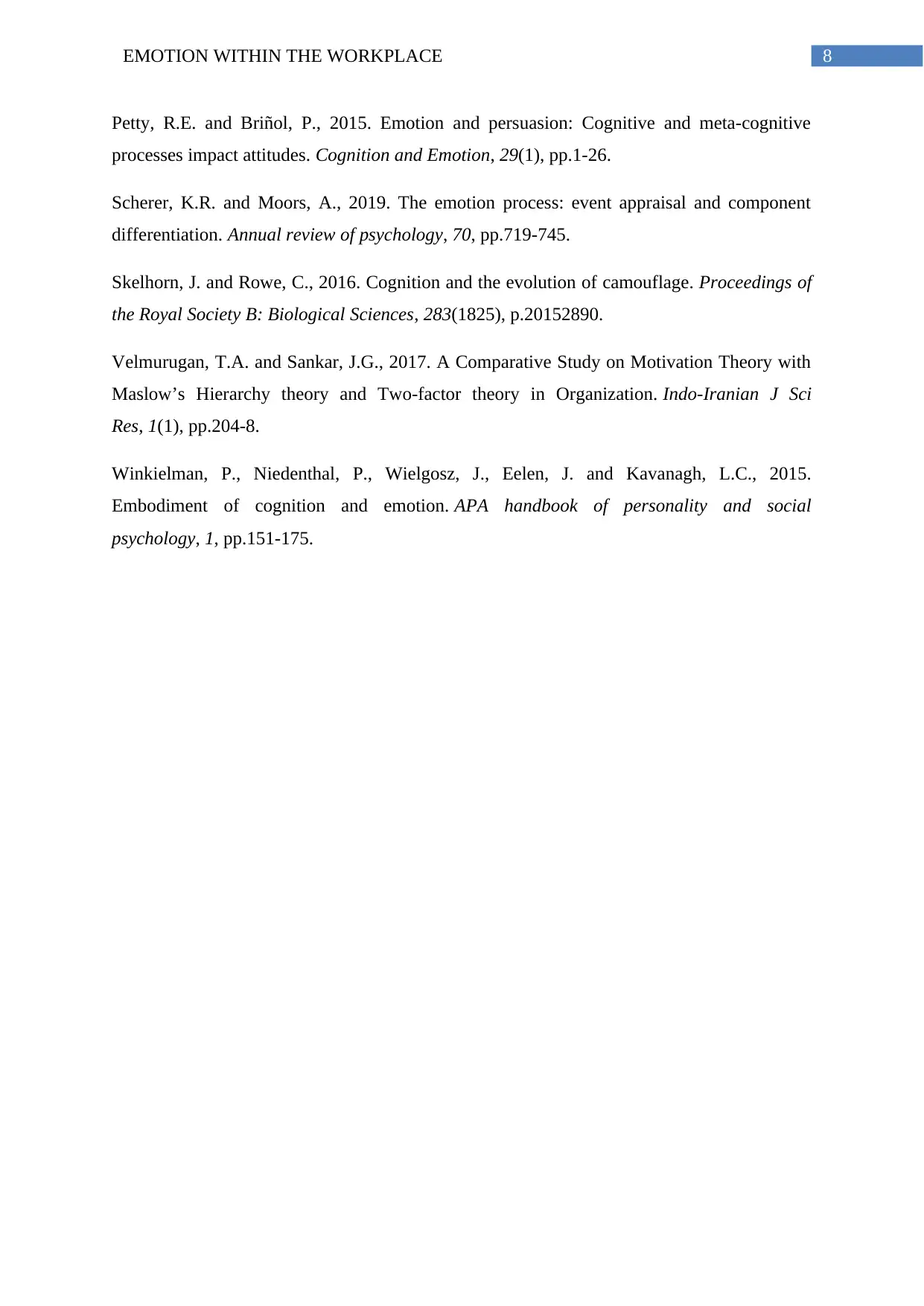
8EMOTION WITHIN THE WORKPLACE
Petty, R.E. and Briñol, P., 2015. Emotion and persuasion: Cognitive and meta-cognitive
processes impact attitudes. Cognition and Emotion, 29(1), pp.1-26.
Scherer, K.R. and Moors, A., 2019. The emotion process: event appraisal and component
differentiation. Annual review of psychology, 70, pp.719-745.
Skelhorn, J. and Rowe, C., 2016. Cognition and the evolution of camouflage. Proceedings of
the Royal Society B: Biological Sciences, 283(1825), p.20152890.
Velmurugan, T.A. and Sankar, J.G., 2017. A Comparative Study on Motivation Theory with
Maslow’s Hierarchy theory and Two-factor theory in Organization. Indo-Iranian J Sci
Res, 1(1), pp.204-8.
Winkielman, P., Niedenthal, P., Wielgosz, J., Eelen, J. and Kavanagh, L.C., 2015.
Embodiment of cognition and emotion. APA handbook of personality and social
psychology, 1, pp.151-175.
Petty, R.E. and Briñol, P., 2015. Emotion and persuasion: Cognitive and meta-cognitive
processes impact attitudes. Cognition and Emotion, 29(1), pp.1-26.
Scherer, K.R. and Moors, A., 2019. The emotion process: event appraisal and component
differentiation. Annual review of psychology, 70, pp.719-745.
Skelhorn, J. and Rowe, C., 2016. Cognition and the evolution of camouflage. Proceedings of
the Royal Society B: Biological Sciences, 283(1825), p.20152890.
Velmurugan, T.A. and Sankar, J.G., 2017. A Comparative Study on Motivation Theory with
Maslow’s Hierarchy theory and Two-factor theory in Organization. Indo-Iranian J Sci
Res, 1(1), pp.204-8.
Winkielman, P., Niedenthal, P., Wielgosz, J., Eelen, J. and Kavanagh, L.C., 2015.
Embodiment of cognition and emotion. APA handbook of personality and social
psychology, 1, pp.151-175.
⊘ This is a preview!⊘
Do you want full access?
Subscribe today to unlock all pages.

Trusted by 1+ million students worldwide

9EMOTION WITHIN THE WORKPLACE
1 out of 10
Related Documents
Your All-in-One AI-Powered Toolkit for Academic Success.
+13062052269
info@desklib.com
Available 24*7 on WhatsApp / Email
![[object Object]](/_next/static/media/star-bottom.7253800d.svg)
Unlock your academic potential
Copyright © 2020–2025 A2Z Services. All Rights Reserved. Developed and managed by ZUCOL.



